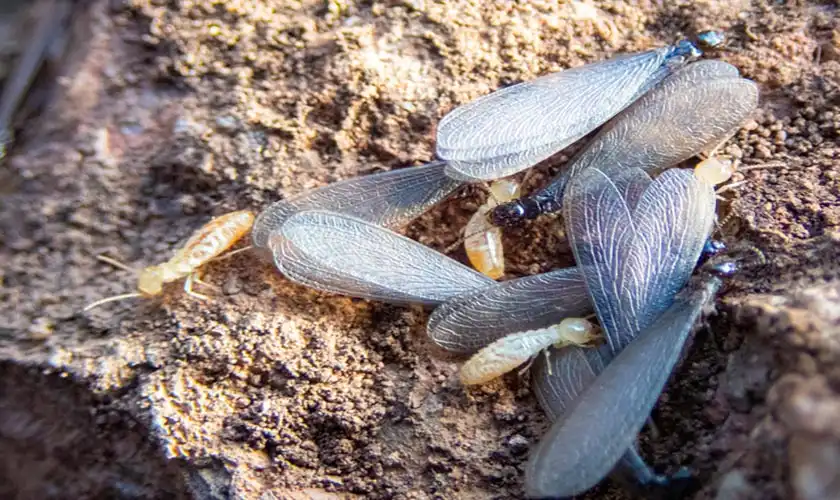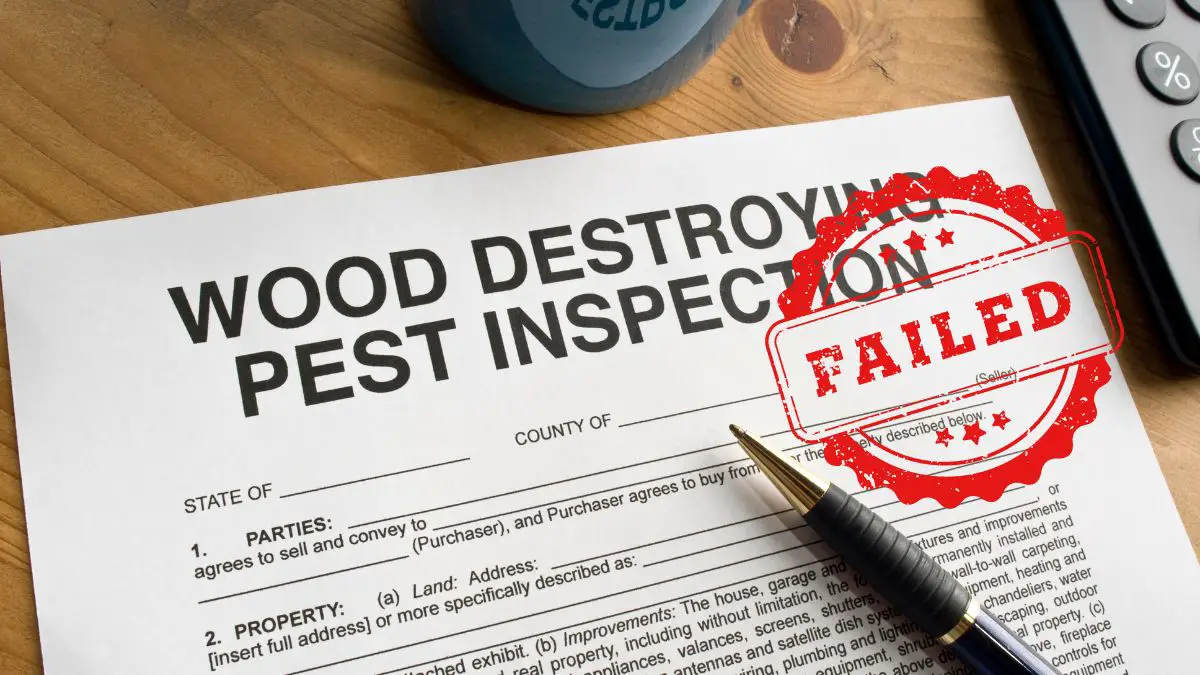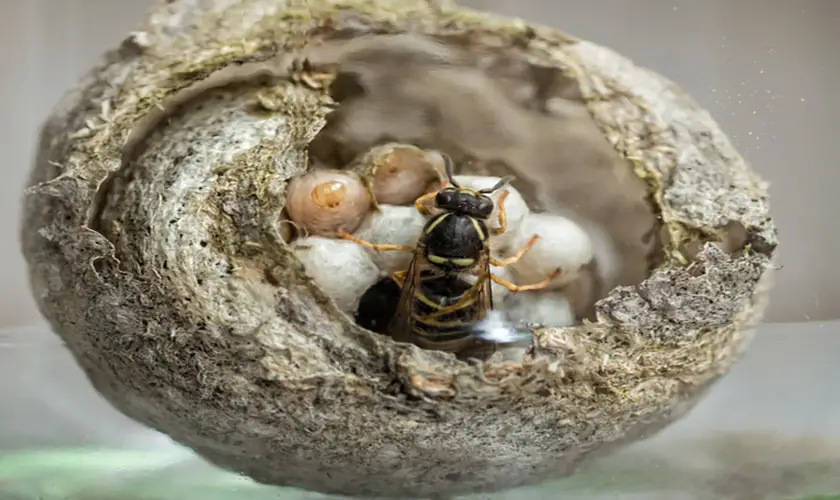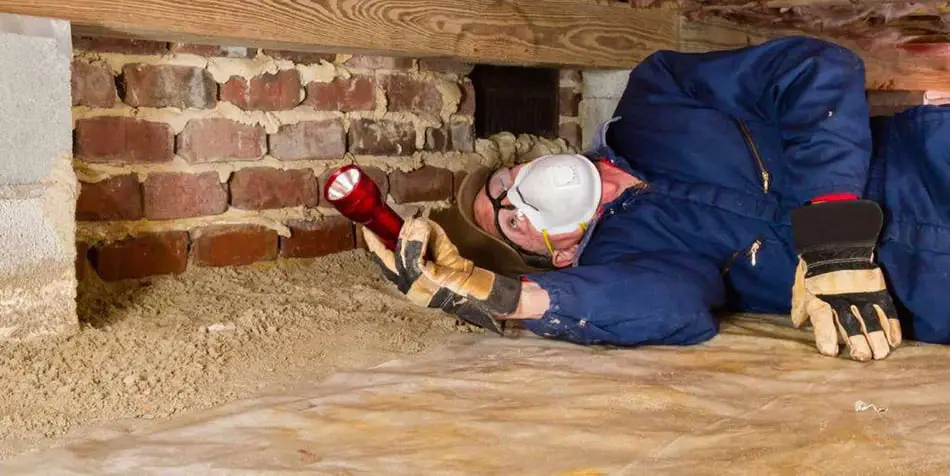Finding winged insects and termites infesting your home can be quite unsettling.
But things can get more complicated if you discover termite wings. If you find wings near your windows or doors, it means there are new termites.
A flying termite varies by color, but its wings are beige or oval-shaped. It roughly measures 3/8th of an inch and has a singular body instead of being broken into segments.
If you see sign of termites with wings swarming around your home, it can make you worry.
But things can get even more complex if you discover leftover termite wings. If you see wings on your window sills and door frames, there are new termites.
A flying termite varies by color, but its wings are typically beige or oval-shaped. They are roughly 3/8th inches and contain a singular body instead of being broken into segments.
Get FREE quotes from licensed pest control technicians in your area today. Whether you need a termite inspection or a full treatment, We Can Help! All technicians are screened, licensed, and insured.
This article will teach you about flying termites and how to protect your home from them.
Different Types of Termites
There are over 2000 known species of termites. The most common types are:
- Subterranean termites can be found in every state except Alaska. This species lives in underground colonies or damp, hidden places aboveground. There are a greatest of 2 million of them.
- Formosan termites are the most aggressive and devious termite species known in science. When ants infest walls, they can cause severe damage to homes. Their large colonies are intricate.
- Drywood termites infest dry wood and can spread throughout wooden structures. Drywood termites live along the Atlantic coast of the Southern United States, from North Carolina to California.
- Dampwood termites attack timber with high moisture content, particularly in damp locations. Dampwood termites don’t usually invade homes because the wood there is dry. These animals live on the West Coast and nearby states. They also live in the dry southwest and southern Florida.
What Do Flying Termites Look Like?
Termites can be confused with several other winged critters. To the untrained eye, they may look similar, but they are different.
But there are ways to distinguish between winged termites and carpenter ants.
1. Wing’s Color & Size
To spot the first difference, look at their wings’ size and shape. It’s somewhat unique.
Flying ants have a darker color and longer front wings than back wings. They have different purposes. They can hide their appearance or provide stability during flight.
A termite’s wings are a beige, almost vanilla color with the same shape and size as its other wings.
A termite’s wings are longer and oval-shaped, equal in size. You can almost say it mimics that of a dried-out maple tree seed and is rather bland-looking.
2. Length of a Winged Termite
Speaking of termite wings, they can be twice their body shape length. A termite can be as large as 3/8th of an inch!
Termites have a singular, long body not broken into segments like flying ant’s bodies.
One large body allows a white ant to be even more identified when coupled with their wings design.
3. Their Antennae
If you look at one, you’ll notice a difference from other insects in their antenna shape.
If you see a bug that looks like winged ants, you’ll notice their bent antennae have two parts.
Termites have shorter, straight termite antennae without any segments. They are like this all the time.
4. Color of a Winged Termite
One final clue as to whether or not you are dealing with a termite activity or an ant boils down to its color.
The colors themselves can vary quite significantly depending on where you are located.
The termites can be light beige, dark brown, or black, depending on the species.
5. Male vs. Female Flying Termites
Female termites release a pheromone when in flight, which attracts potential male termites. Thus, a termite swarm is male termites attracted to the female pheromones during the breeding season.
After the termites finish their mating ritual, the female removes her wings. She does this to start a new termite nest in the ground.
Where Do Flying Termites Come From?
The question is interesting, but it becomes more complicated as we delve deeper into it.
Flying termites come from the same place as all other termite types, which would be a termite colony.
Termites can become three types that add something extra when they move in their lifecycle.
Life Cycle of a Termite
The life cycle starts as an egg. It becomes more mobile and annoying when they hatch into larvae.
The larvae will grow into nymphs. This is when a termite changes.
- worker termites
- soldier termites
- flying termites
Termites grow sets of wings to find a new area for another settlement.
When it finds a place, it loses its wings and becomes a King or Queen termite, depending on gender.
How Do I Get Rid of Flying Termites in My House?
To cut termites, killing them is the simplest method. But this oversimplifies a big termite issue.
If you have flying termites in your home, you are likely amid a full-on infestation.
Treating a termite infestation is not something that you should do alone.
If you don’t have experience dealing with white ants, it can be hard to know how to handle them. But there are long-term solutions available to help you win the fight.
You can use borax powder to treat affected areas. Mix it with water and spray it in those areas. But, this method may not guarantee the elimination of the colony. In the long term, it’s like using a band-aid on a wound that requires stitches.
To find the best solution, seek help from an experienced professional.
Any pest control company, like Terminix or Orkin, can assess how bad your infestation is. But you and the professionals will need to have a plan to cut the pests once and for all.
Using a company has a perk: they can be held accountable for not removing all pests. If the first treatments work, they can inspect your home for years.

Do Termites Fly After Rain?
Termites after rain because the air is still and calm.
The calm environment lets them travel far and find a good spot for a new home.
Considering that information doesn’t always mean you’ll only see them flying after heavy rains. This is especially true if you live in a dry, arid climate with infrequent rainfall.
Even a localized species of termite is referred to as “Desert Termites.”
Are Flying Termites Harmful?
Termites, usually, don’t bite people, so they can’t harm you. They are annoying. Still, they can hurt you.
If the problem worsens, it can cause emotional trauma. Finding out your home is falling apart can hurt your mental health.
When flying termites appear, the main worry is that they are trying to start a colony.
If white ants are in your home, your entire household is the buffet they seek to destroy and gorge themselves on.
If you see flying termites in your home, it’s important to act quickly and get professional help. The longer you wait, the harder they are to eliminate and the more expensive it becomes.
Why Do Flying Termites Suddenly Appear?
In most cases, flying termites do not precisely appear. You just noticed that there are more of them moving around.
Sometimes, when the right conditions happen, you might see many more flying termites.
Still, typically, it just boils down to you not actively looking for them in the first place.
Termites are most active in spring and summer, especially after rainstorms.
Additionally, termites are highly attracted to bright lights. If all these variables align simultaneously, you might see a huge swarm of flying termites. Still, there is a method to the madness.
Do Swarmers Mean I Have Termites?
If you see a termite swarm or “swarmers,” your home may be chosen or already infested. Termites are looking to expand their territory.
Either way, you view it, you are not in a good situation. To avoid trouble, investigate further and consult a professional. The situation can escalate.

Why Do Flying Termites Mean Serious Trouble?
Flying termites can cause serious damage to your home and your wallet association.
Still, the biggest reason to take them seriously would be the repercussions that could befall you if you ignore the issue.
The first problem to consider is the long-term structural integrity of your home.
It is a fact that termites eat wood. The studs in your walls, the framework of your home, and the foundations of your floor all have wood inside them.
Termites can make big holes in the floor and walls, which can make things unstable.
Safety being the primary concern, termite damage can be expensive repairs.
Even worse, you can’t start repairs until the infestation is gone. Otherwise, termites may cause more structural damage in different locations. As a result, you’ll lose money in every way.
While your home is being treated and repaired, you’ll need to find another place to stay. This might mean relying on your family or booking a hotel.
At the same time, you wait for things to get back on track, so having “serious trouble” is quite an understatement.
Do Flying Termites Mean an Infestation?
If you see a flying termite, it doesn’t mean you have a big problem, but it’s still important.
The costly damage that can occur is not worth taking the risk of shrugging the sighting off as a one-off.
You can learn much about the problem by looking at the situation and the area.
Anything from large clumps of discarded wings to mud tubes can tell you things are getting out of hand.
You can also place your ear to your walls and listen closely. If you hear clicking or scraping noises, you might hear soldier termites eating your walls.
Check the corners of your home’s walls and exterior for termite droppings.
You can also check for mud tunnels leading from the ground to a window or entry point into your home.
If you see any of those signs, you should seek help because you probably have an infestation.
If you get help fast, you can eliminate these pests and learn how to prevent them from coming back.
How Long Do Winged Termites Live?
If the winged termite cannot find a place to start a new colony, it usually dies shortly after flying.
Still, if they do find a new home, you can have a new roommate for decades if left unfound.
Assuming the winged type of termite fails its only purpose in life, it will not cause you any concern.
Even if successful, it won’t die for 15-17 years. It will create descendants that spread misery to neighbors and potentially your children.
As a fun fact, some of the longest-living queen termites ever recorded have lived up to 30 years.
A queen termite can produce 15 generations of termites in the worst-case situation.
What Attracts Termites to a House?
When termites search for a new home, they look for an easy access point to start building colonies.
1. Anything with Cellulose
Termites will be attracted to anything that contains cellulose. These pests can enter through anything from cracks to the windows or walls of your home.
Termites can enter your home through openings, especially if you’ve opened them for ventilation.
Whether white ants can get in quickly is their prime target for a home.
2. Bright Lights
At night, winged termites are drawn to bright lights like your windows, which can invite them inside.
Other outside sources could also create a wonderful home for termites outside your home.
3. Wood Debris
Termites may live in wood debris near your home, like firewood, tree stumps, or mulch.
4. Some Defense Against Termites
To protect your home from termites, take action to prevent them and regularly check for entry points on the outside.
For this precise reason, one of the best defenses against termites is keeping your home and yard clean and tidy. This method also works for other annoying insects that could bother you. You can solve two problems at once.
Can Winged Termites Affect Selling a Home?
Finding termites in a home can worry buyers and sellers, with pros and cons.
Suppose you are looking to buy a home, and you discover termites. In that case, you can immediately begin talks on lowering the price.
To do this, you would need to write it in a legal agreement. In most states, the original homeowner has to treat a termite problem.
Another thing to be wary of would be handling the situation, especially if the house was previously infested.
Yet, the home had already been sold without the buyer knowing of said infestation.
If that happens, the buyer can take the seller to court and ask for compensation. This includes the costs of fixing the damage and treating the infestation.
Being honest upfront is not only morally right but can also save you money on legal fees.
You’ll Need Professional Guidance
If you see the small signs of a problem, it’s usually too late for a DIY fix.
A termite invasion shows great strength and importance, so it’s a big problem. If you have termites, they swarm around your home on the floors and walls.
Due to this, spraying in a few corners will not be enough to handle the severity of a problem like this. Many people don’t have the tools or know-how to handle this problem and find true peace.
If you’re unsure about termites, call a professional for an inspection. This is like the first step in a great attack against the termites in your home.
Termite inspections have different prices. Depending on your suitable location, you may pay between $50 and $300.
Usually, the national average for your initial inspection is around $100.
Following Up On the Inspection
After getting your home inspected, you can expect a few things to happen. Imagine if the expert says you were fortunate to see some curious flying termites.
If that happens, they will probably teach you how to keep your home safe and schedule pest inspections.
Suppose you were unlucky, and the professional does happen to find evidence of an infestation.
If that happens, they will discuss a detailed plan with you to treat your home. They will do it without disrupting your life.
The agent may help you find a local contractor to fix your repairs after removing the insects. This will make your recovery easier.
There is no guarantee, so you may have to find a nearby hardware store or expert for these repairs.
Flying Termites FAQs
Should I worry if I see flying termites?
If you see flying termites, it means there’s a nearby colony. This can be dangerous because they can damage structures and reproduce. Termites are hard to detect and can lead to costly repairs if left untreated. Check your property for warning sign of trouble. Talk to an expert, and take quick action to fix the problem and avoid big damage.
Do flying termites mean you have termites?
Seeing flying termites (swarmers) indicates an established colony of termites nearby. They emerge during the swarming season, often after rain in warmer months. Outdoor sightings suggest proximity, while indoor sightings signal an active infestation. Look for mud tubes, hollow wood, and frass as extra signs.
Are flying termites harmful?
Flying termites, or termite swarmers, don’t harm humans but signify potential property damage. They feed on wood, posing a potential threat to structures and furniture. Swarming inside indicates an active nearby infestation. While they don’t bite or diseases, some may experience rare allergic reactions.
What do you do when you see flying termites?
If you notice flying termites, remain calm and capture a few for identification—dim light source to deter them and seal entry points in your home. Check for signs of termites. Ask pest control experts about assessment and treatment options. To prevent future infestations, make sure you have good drainage and inspect.
Conclusion
Discovering flying termites near your home can be a problem, but it doesn’t mean your home is damaged.
But it means you are at risk and must take action to protect your home and finances.
Get FREE quotes from licensed pest control technicians in your area today. Whether you need a termite inspection or a full treatment, We Can Help! All technicians are screened, licensed, and insured.










